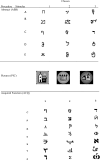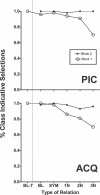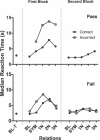Effects of a meaningful, a discriminative, and a meaningless stimulus on equivalence class formation
- PMID: 22389524
- PMCID: PMC3292228
- DOI: 10.1901/jeab.2012.97-163
Effects of a meaningful, a discriminative, and a meaningless stimulus on equivalence class formation
Abstract
Thirty college students attempted to form three 3-node 5-member equivalence classes under the simultaneous protocol. After concurrent training of AB, BC, CD, and DE relations, all probes used to assess the emergence of symmetrical, transitive, and equivalence relations were presented for two test blocks. When the A-E stimuli were all abstract shapes, none of 10 participants formed classes. When the A, B, D, and E stimuli were abstract shapes and the C stimuli were meaningful pictures, 8 of 10 participants formed classes. This high yield may reflect the expansion of existing classes that consist of the associates of the meaningful stimuli, rather than the formation of the ABCDE classes, per se. When the A-E stimuli were abstract shapes and the C stimuli became S(D)s prior to class formation, 5 out of 10 participants formed classes. Thus, the discriminative functions served by the meaningful stimuli can account for some of the enhancement of class formation produced by the inclusion of a meaningful stimulus as a class member. A sorting task, which provided a secondary measure of class formation, indicated the formation of all three classes when the emergent relations probes indicated the same outcome. In contrast, the sorting test indicated "partial" class formation when the emergent relations test indicated no class formation. Finally, the effects of nodal distance on the relatedness of stimuli in the equivalence classes were not influenced by the functions served by the C stimuli in the equivalence classes.
Keywords: Stimulus Equivalence; acquired discriminative function; college students; comparison selection in matching to sample trials; enhanced equivalence class formation; meaningfulness; nodal distance effects.
Figures





Similar articles
-
Enhancement of equivalence class formation by pretraining discriminative functions.Learn Behav. 2015 Mar;43(1):20-31. doi: 10.3758/s13420-014-0158-6. Learn Behav. 2015. PMID: 25425295
-
Arbitrary conditional discriminative functions of meaningful stimuli and enhanced equivalence class formation.J Exp Anal Behav. 2015 Mar;103(2):349-60. doi: 10.1002/jeab.141. J Exp Anal Behav. 2015. PMID: 25766450
-
Enhanced equivalence class formation by the delay and relational functions of meaningful stimuli.J Exp Anal Behav. 2015 May;103(3):524-41. doi: 10.1002/jeab.152. J Exp Anal Behav. 2015. PMID: 25969335
-
Training order and structural location of meaningful stimuli: effects on equivalence class formation.Learn Behav. 2015 Dec;43(4):342-53. doi: 10.3758/s13420-015-0183-0. Learn Behav. 2015. PMID: 26077441
-
The Problem of Class Breakdown in Sidman's (1994, 2000) Theory about the Origin of Stimulus Equivalence.Perspect Behav Sci. 2023 Feb 1;46(1):217-235. doi: 10.1007/s40614-023-00365-2. eCollection 2023 Mar. Perspect Behav Sci. 2023. PMID: 37006605 Free PMC article. Review.
Cited by
-
Enhancement of equivalence class formation by pretraining discriminative functions.Learn Behav. 2015 Mar;43(1):20-31. doi: 10.3758/s13420-014-0158-6. Learn Behav. 2015. PMID: 25425295
-
Emotional Faces in Symbolic Relations: A Happiness Superiority Effect Involving the Equivalence Paradigm.Front Psychol. 2019 Apr 30;10:954. doi: 10.3389/fpsyg.2019.00954. eCollection 2019. Front Psychol. 2019. PMID: 31114529 Free PMC article.
-
Meaningful Stimuli and the Enhancement of Equivalence Class Formation.Perspect Behav Sci. 2017 Dec 27;41(1):69-93. doi: 10.1007/s40614-017-0134-5. eCollection 2018 Jun. Perspect Behav Sci. 2017. PMID: 32004364 Free PMC article.
-
Summation in Convergent Multiple Control Over Selection-Based Verbal Behavior.Anal Verbal Behav. 2023 Sep 21;40(2):326-344. doi: 10.1007/s40616-023-00194-z. eCollection 2024 Dec. Anal Verbal Behav. 2023. PMID: 40124233 Free PMC article.
-
Relating in the Wild: Toward an Analysis of Equivalence Relations Under More Naturalistic Conditions.Perspect Behav Sci. 2024 Aug 17;47(3):603-626. doi: 10.1007/s40614-024-00420-6. eCollection 2024 Sep. Perspect Behav Sci. 2024. PMID: 39309240 Free PMC article.
References
-
- Arntzen E. Probability of equivalence formation: familiar stimuli and training sequence. The Psychological Record. 2004;54:275–291.
-
- Arntzen E, Holth P. Differential probabilities of equivalence outcome in individual subjects as a function of training structure. The Psychological Record. 2000;50:603–628.
-
- Arntzen E, Lian T. Trained and derived relations with pictures as nodes. The Psychological Record. 2010;60:659–677.
-
- Augustson E.M, Dougher M.J. The transfer of avoidance functions through stimulus equivalence classes. The Journal of Behavior Therapy and Experimental Psychiatry. 1997;28:181–191. - PubMed
-
- Barnes D, Browne M, Smeets P, Roche B. A transfer of functions and conditional transfer of functions through equivalence relations in three- to six-year-old children. The Psychological Record. 1995;45:405–430.
Publication types
MeSH terms
LinkOut - more resources
Full Text Sources

